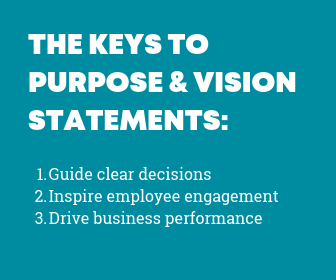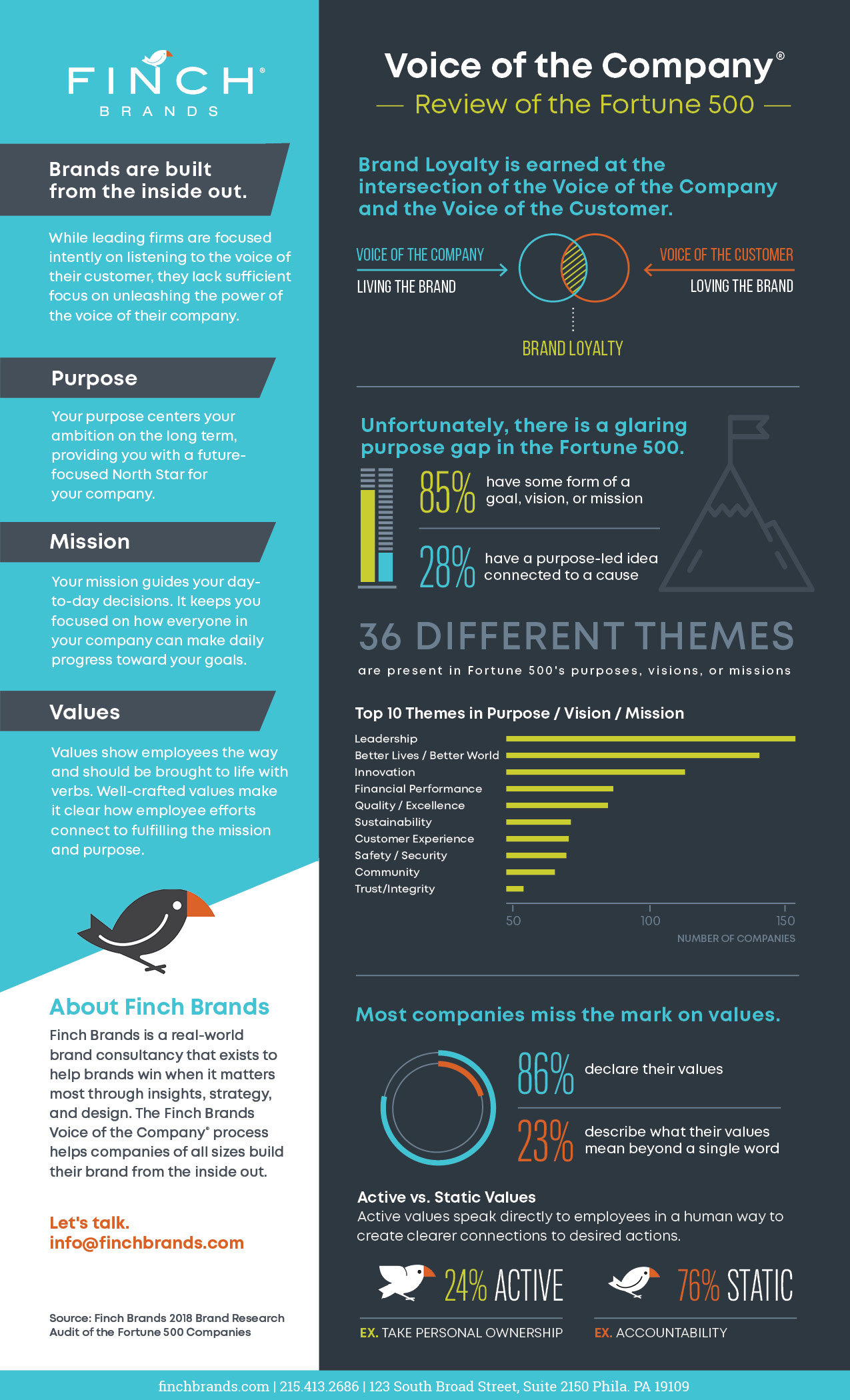How Company Purpose Drives Performance

The Voice of the Company®: Purpose, Mission and Values
In an era of accelerating digital disruption, the commoditization of products and services is sweeping across industries faster than ever, and the need for differentiation vs. the competition has never been more urgent. Increasingly, customer experience is becoming the central focus for driving differentiation and brand loyalty.
Yet, how do you accomplish this in a way that will stick? There is perhaps no issue keeping leaders in the C-Suite up at night more than this. In pursuit of this goal, tens of billions of dollars are thrown at CX projects that often lack a coherent connection to corporate strategy and offer fleeting benefits rather than sustained competitive advantage.
This approach can create disjointed customer experiences with pockets of excellence and pits of inconsistency, siphoning off the ROI of these investments and leaving companies no closer to achieving their goal of sustained brand differentiation through remarkable customer experiences than where they started.
Finch Brands is a brand consultancy that conducted a comprehensive audit of the Fortune 500, with a special focus on what the world leaders in sustained customer experience excellence have in common.
We found 3 key areas where they stand apart from the crowd:
1. They have a focused, purpose-driven aspiration for the future
This declaration of the firm’s over-arching aspiration must be focused.
A compass isn’t a compass if it points in all directions. Yet that’s exactly the trap most CEO’s fall into when declaring their company purpose or company vision.
Within the Fortune 500, the average company has between 3 and 4 different themes present at the purpose / vision / mission level, spanning 36 unique focus areas, with examples such as leadership, customer experience, and sustainability.
Company purpose / vision statements often end up becoming a muddled checklist designed to satisfy myriad stakeholder groups rather than a laser-focused statement that guides clear decisions, inspires employee engagement, and drives business performance.

Contrast this diffuse, multi-theme approach with a firm like Amazon, which aspires, “To be the world’s most customer centric company,” or Nordstrom, which aims, “To provide outstanding service every day, one customer at a time.”
There’s no question what’s most important to these companies and where their brand differentiators lie. It’s no accident that these are among the world leaders in delivering remarkable (and remarkably consistent) customer experiences, as employees at all levels of each organization know where to focus their energy.
The value of intense focus isn’t limited to customer experience. Google’s brand purpose, “To organize the world’s information and make it universally accessible and useful,” provides a precise north star for the company’s steady drumbeat of innovation and acquisition.
These statements must be purpose-driven
Being focused doesn’t matter if it doesn’t connect with internal and external audiences on an emotional level, as emotion is what drives people to action.
Contrast Wells Fargo’s fairly generic purpose, “to satisfy our customers’ financial needs and help them succeed financially,” with that of Synchrony, which focuses its energy on the goal, “To build a future where every ambition is within reach.”
Which company would you rather work for? The latter speaks not only to the ambition of the customers that Synchrony’s employees serve, but also to the career aspirations of Synchrony’s employees, and the goals of strategic partners and shareholders.
Defined well, an over-arching company purpose artfully addresses all stakeholders’ deepest needs without falling into the “all things to everyone” trap.
2. They clarify how they employees can bring the company purpose to life
It’s not enough to declare a focused, purpose-driven direction. You next need to make it clear to employees how they can align what they do every day with contributing toward the shared goal.
There are two key avenues that purpose-driven companies often pursue to accomplish this:
Company Values
Company values should be a unique collection of statements that clearly define the specific employee behaviors that will bring the brand purpose to life.

Our research shows that while 87% of the Fortune 500 have declared company values, most do not follow best practices in this area, such as Simon Sinek’s assertion that to be truly effective, company values must use verbs.
Our audit found that 4 out of 5 of Fortune 500 firms are still using the legacy approach of declaring company values using static nouns that are difficult for employees to translate into their everyday behaviors.
In addition to these best practice gaps, few large companies have values that go beyond generic, broad-based concepts that can apply to any company in any situation like “Integrity” or “Collaboration”.
While these broad-based concepts can play an important role in company values, their values are often limited to these territories and there is little connectivity between chosen values and what the organization is specifically looking to accomplish with its brand purpose.
Customer Experience Principles
Customer Experience Principles live one level below company values, and are even more specific in providing concrete guidance for how front line employees should interact with customers.

A terrific example of this can be found at Ritz Carlton, which brings its customer experience principles to life with its motto and 3 Steps of Service.
Ritz Carlton Motto
We are Ladies and Gentlemen serving Ladies and Gentlemen
3 Steps of Service
- A warm and sincere greeting. Use the guest’s name.
- Anticipation and fulfillment of each guest’s needs.
- Fond farewell. Give a warm good-bye and use the guest’s name.
Ritz Carlton starts by elevating its employees to the level of its distinguished guests so that they feel like peers in this exceptional environment. They then use their 3 Steps of Service to make it clear to their team what exceptional, repeatable guest interactions look like.
An employee could miss the Ritz Carlton’s entire orientation and training curriculum and still deliver an amazing experience to guests if they were handed a note card with this guidance and all they did was follow these simple steps.
3. They operationalize their company purpose so that it drives internal operations
This is one of the biggest differentiators between companies that consistently lead on customer experience and those that lag.

Your company purpose and values need to be more than a poster on the wall in the cafeteria or a buried page in your annual report.
They need to be operationalized in order for them to add any real value to company performance. This includes obvious areas like hiring, orientation, and training.
In hiring, some firms accomplish this through behavioral interview questions designed to illustrate how employees have exhibited certain important values through prior work experiences, or how they might apply them in hypothetical situations.
Nordstrom is famous for having one rule of service – “use good judgement in all situations”. The reason they are able to boil things down to such a simple guiding principle is because they have a rigorous hiring process that yields employees that demonstrate good judgement.
After hiring, having your company’s purpose and values front and center in orientation and training makes a statement right out of the gates to new employees that this stuff really matters. The best firms then extend further, demonstrating the company’s commitment to living the company purpose and values by incorporating them into objective setting and employee recognition and appraisal systems.
As the famous W. Edwards Deming saying goes, “what gets measured gets done.”

To bring your company purpose and values to life, you must align incentives to encourage the right behaviors and provide feedback mechanisms to keep individuals and the organization on track.
3 key areas to stand apart from the crowd:
1. Have a focused, purpose-driven aspiration for the future
2. Make it crystal clear to employees how they can bring this purpose to life
3. Operationalize the brand purpose so that it drives internal operations

Looking to Define Your Company Purpose, Mission, or Values?
Finch Brands is a brand consultancy with more than two decades of experience helping leading companies become more customer-centric. Read our client success stories here.
Contact us if you are you looking to define the Voice of the Company® in your organization to make brand a stronger driver of business performance.






